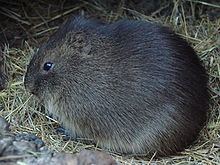Higher classification Cavia | Phylum Chordata Scientific name Cavia magna Rank Species | |
 | ||
Similar Cavia, Shiny guinea pig, Santa Catarina's guinea pig, Rodent, Cavies | ||
The greater guinea pig, Cavia magna, is a species of rodent found in the coastal strip of Brazil and Uruguay, where it lives in moist grassland and marshes.
Contents
Description
A large rodent, the greater guinea pig grows to a total length of 310 mm (12.2 in) and weight of 636 g (22.4 oz) for males and a total length of 303 mm (11.9 in) and weight of 537 g (18.9 oz) for females. The dorsal fur is dark agouti brown and the underparts are reddish brown. It is semiaquatic and has membranes joining the toes.
Its karyotype has 2n = 64 and FN = 128.
Distribution and habitat
This species is native to the coastal strip of land in eastern Uruguay and southeastern Brazil. Its typical habitat is moist grassland, marshes, the edges of woodland and little valleys.
Behaviour
The greater guinea pig is a herbivore. It is a solitary animal and has a complex network of tunnels and runways through the vegetation. The home range is variable and seems to be related to the animal's size, its sex, and the water level in the area. Females seem capable of breeding at any time of year but births predominate in spring and the early part of summer. Females may have three litters in the year. The gestation period is about 64 days and the litter size is very small (1 or 2 pups). The young are quite large when born and grow fast, and some females born in the spring, themselves breed successfully when between 30 and 45 days old. This small mammal is unusual in that it produces a small number of precocial offspring with a high survival rate when it might have been expected to produce large litters of altricial young.
Status
The International Union for Conservation of Nature has rated the conservation status of the greater guinea pig as being of "least concern". It has a restricted range but has a total area of occupancy of more than 20,000 square kilometres (7,722 sq mi). It is believed to have a large total population, and although the population is thought to be slightly declining in Uruguay, this is not at a rate sufficiently significant for it to be listed in a more threatened category.
